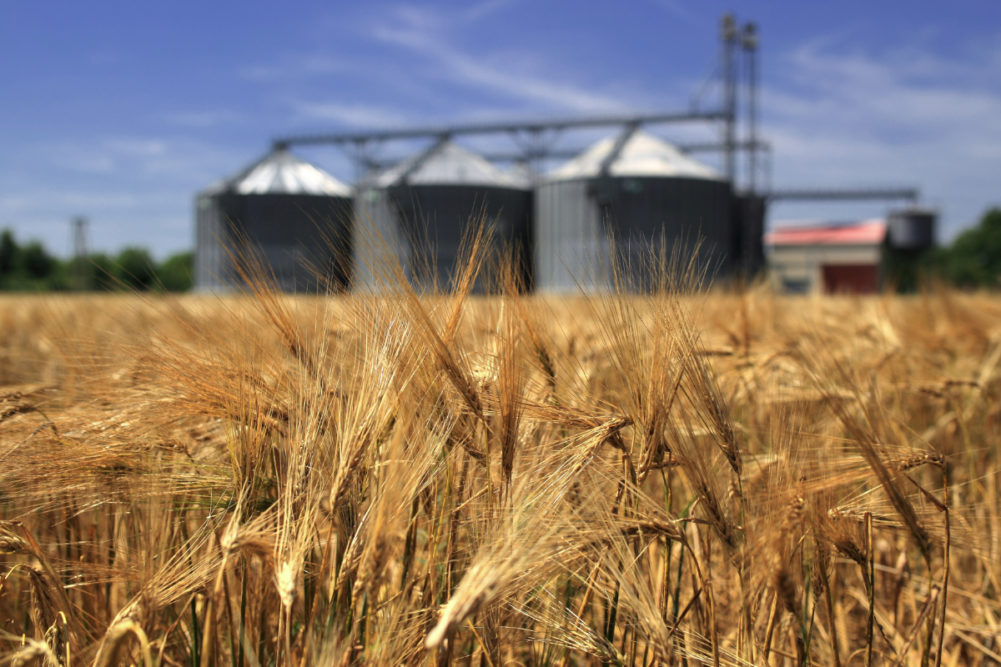KANSAS CITY, MISSOURI, US — As the winter wheat harvest advanced rapidly northward through the central Plains and Central states toward a timely conclusion, producers in the drought-plagued northern Plains and grain markets braced for what increasingly was expected to be a small, quality-challenged 2021 US spring wheat crop.
The US winter wheat harvest was 73% completed by July 18 in the 18 principal production states, the US Department of Agriculture said. That mirrored exactly the progress a year earlier and was near 74% as the 2016-20 average for the date.
In hard red winter wheat country, Oklahoma farmers have completed combining, and the harvest’s end was in sight in Texas (99% completed), Kansas (96%), Colorado (61%) and Nebraska (60%). Combining was 33% completed in South Dakota and 10% in Montana, which was near the average progress for the date for those states.
Most new crop hard red winter wheat samples tested off the combine or offered for sale on the spot market in late June and July had good quality, but proteins at that time on average were lower than producers, traders and millers had hoped. Timely rainstorms in late spring and early summer were beneficial to the developing crop, especially during the grain filling stage. Afterward, hot, dry days were in short supply, and low stress benefited yields but lowered average protein levels. Another round of rain in early July appeared to lighten average test weights in western Kansas and eastern Colorado.
“In early-harvest offers, we certainly saw lower proteins and better test weights,” said a grain buyer for a major milling company. “Then the rain that came in 10 to 14 days ago slowed harvest progress, and since then, we’ve seen a little bit higher protein, but test weights have dropped. Once elevators have a chance to catch their breath and do a bit more blending rather than trying to survive by loading out wheat as quickly as it comes in, it should even out a little bit. It’s looking like protein will be a little higher than the industry most recently was anticipating. We’ll see some higher proteins up north and some mid-proteins offered in central Kansas. Looking to southern Kansas and Oklahoma, we’ll start to see some lower-protein wheat offered again.”
The protein value discrepancy was apparent in the hard red winter wheat cash basis in July as harvest pressure mostly weighed on 11% protein premiums and left 12% proteins intact. Meanwhile, cash wheat premiums for wheat with protein above 13% recently jumped 10¢ a bu higher and has remained there for the month so far.
Soft red winter wheat
In the Central states, a mild winter and early emergence from dormancy produced a soft red winter wheat crop with good quality characteristics and excellent yields. The return of cool temperatures in mid-spring ended up putting the harvest on a more typical timeline. The USDA said harvest completion by July 18 was 96% in Missouri (97% a year ago, 96% as the recent five-year average for the date), 97% in Illinois (93%, 96%), 88% in Indiana (94%, 93%), 84% in Ohio (94%, 89%) and 47% in Michigan (42%, 39%). Good to excellent yields, especially in the key production region of northern Ohio, were a key feature of the 2021 soft red winter crop.
“Ohio had a great harvest for the most part,” a miller said. “Most of it came out of the field before the rains started. Wheat still in the fields right now is likely to be of lesser quality, but the majority of it came off in good time and in good shape. Wheat came out of dormancy early with an early spring and got some real nice growth on, added some tillers maybe, and then weather cooled off and slowed crop progress back down, which helped during head fill, put more wheat in the heads there for better yields, and we ended up with about a normal harvest period around the Fourth of July.”
US Wheat Associates, using data generated by Great Plains Analytical Laboratory, said with 230 of an expected 300 samples tested by July 16, the 2021 soft red winter wheat crop was averaging 59.5 lbs per bushel in test weight (58.2 lbs as the 2016-20 average), 34.3 grams in thousand kernel weight (32 grams), 291 seconds in falling number (313 seconds), 0.6% damage (0.9%), with 9.4% as the average protein (9.6%). The average grade was No. 2 soft red winter, same as the five-year average.
Anecdotally, US Wheat Associates pointed to pockets of heavy production that were seeing far higher than average yields, leaving millers satisfied with new crop supplies.
“I’ve heard more growers this year say they’ve harvested more than 100 bus an acre than ever before in my life,” one miller said.
Some growers with large acreage seeded to wheat reported average yields as high as 120 bus an acre with some low-lying parts of their fields turning out up to 150 bushels an acre on combine yield monitors.
“It was phenomenal, just outstanding, almost unbelievable,” he said. “Will the whole state average that, no, but I think we’re going to be above trendline averages for Ohio, which is around 71 to 72 bushels. I think we’re going to beat the average yield this year. Some farmers seeded more wheat than usual, and what a year to do it: great yields, great prices, good quality, what more could he want?”
A lack of stress on the soft winter crop meant proteins would be about average, 9%, near perfect for many soft wheat grinds.
“For the product we make pastry flours for cakes, donuts, cookies, the problem would come with too high an average protein,” the miller said. “Our protein is always going to average around 9% year in-year out, some years 8%, some years a strong 9%. We weren’t stressed at all here in 2021, had a really mild winter, and the crop came through winter well. Down south, protein tends to be a little higher because the crop sees more stress, so it can be between 9% and 10%.”
The soft red winter wheat crop had virtually no issues with pest or disease pressure, including vomitoxin. With most of the crop taken from the fields prior to a spate of precipitation in mid-July, sprout damage also was of little concern, although experts said what remains in the fields may see sprout damage, lower falling numbers or both.
To the north, Michigan producers last week were making good headway on collecting the crop in sunny, clear weather featuring 80° temperatures. But many were dealing with plenty of sprout damage after atypical July rains coupled with high humidity delayed the harvest by up to two weeks.
A Michigan miller pegged harvest completion by July 20 at around 60%.
“Crop quality in general is pretty good, and growers are reporting fairly decent yields,” he said. “Michigan typically has very good yields. We sort of lead the nation in yields per acre. For farmers to say they’re getting 80 to 90 to 100 bushels an acre is not uncommon.”
The USDA rated the condition of Michigan winter wheat at 58% good to excellent on July 18, up from 56% the prior week and 46% two weeks earlier.
Sprout damage was essentially the only concern with the crop, although falling numbers were below average.
“One of our perennial nemeses on wheat is vomitoxin, and there is none in 2021, so that’s been a good thing,” the miller said. “However, we run a falling number test on every load, so while we’re still working through those as we go, this year a lot more wheat is in the 250 to 300-second range, or a little bit below that, compared with a typical year, when we would see all the wheat coming in at 300+ seconds.”
Hard red spring wheat
Drought conditions were the dominant feature in spring wheat country, which continued to support wheat prices. The harvest was expected to get underway within days.
The USDA rated only 11% of the US spring wheat crop in good to excellent condition on July 18, down from 16% a week earlier and compared with 68% good to excellent a year ago. Sixty-three percent of the crop was in poor to very poor condition on July 18, up from 55% a week earlier and dwarfing 7% so rated a year earlier.
Spring wheat conditions varied by state. The worst conditions were in Washington, followed by South Dakota and North Dakota. Good-to-excellent conditions on July 18 were 22% in Idaho (16% a week earlier), 15% in Minnesota (28%), 12% in Montana (16%), 11% in North Dakota (16%), 5% in South Dakota (3%), 0% in Washington (1%).
Crop conditions this year have been likened to those seen in 1988, another year of severe drought across the northern Plains. Looking back to July 1988, conditions were even worse than those the USDA currently estimates for the 2021 crop. The USDA on July 18, 1988, rated the condition of the 1988 spring wheat crop at 7% good, 20% fair and 73% poor to very poor.
High temperatures recorded in the northern Plains for most of the 2021 crop’s development were forecast to continue into late July. Only scattered, intermittent rains were forecast. In the absence of any truly beneficial rains, the hard red spring wheat crop continued to head out much faster than normal, reaching 80% by July 18.
“Producers report some fields look good, depending on planting date and moisture received,” US Wheat Associates said in its weekly harvest report dated July 16. “However, compounding pressures from drought and heat are expected to deliver below-average yields and above-average protein.”
The USDA in its July 12 Crop Production report forecast the production of spring wheat other than durum at 344.575 million bushels, down 41% from 585.99 million bushels in 2020, based on a yield of 30.7 bushels an acre, down 17.9 bushels from last year, and a harvested area of 11.2 million acres, unchanged from June but down 7% from last year. Of the projected other-spring wheat total, 305.395 million bushels was hard red spring wheat, down 42% from 2020. If realized, it would be the smallest hard red spring production since 181 million bushels in 1988.
Some earlier-planted fields were ripening quickly, so the first combines were expected to enter fields within days, the North Dakota Wheat Commission said. However, “producers in the driest areas continue to make choices on abandoning or haying their wheat crop depending on yield potential,” the NDWC said on July 13.
As if the dire moisture straits weren’t enough to roil the market for spring wheat, producers were monitoring the presence grasshoppers and sawflies, both noted in some fields, and hoping they would not wreak extensive damage on the troubled crop.






